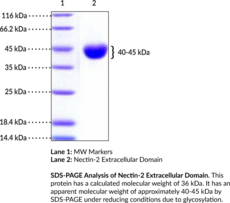Territorial Availability: Available through Bertin Technologies only in France
- Correlated keywords
- CD 96 112 226 C 1 2 TGF?1 IFN? costimulatory DNAM1 OV90 MDAMB231 MDAMB MB231 Gln 32 SDSPAGE Mph PRR 2 PVRL2 PVRL AI987993 AI 987993 325026 AI325026 pvr pvs
- Product Overview:
Nectin-2, also known as CD112, is a member of the nectin family of adhesion molecules that mediates the formation of adherens junctions and regulates immune cell activation.{56107} It contains an N-terminal extracellular domain with three immunoglobulin-like (Ig-like) loops, C1-like and C2 domains that mediate dimerization, a transmembrane segment, and a C-terminal cytoplasmic tail that binds to the actin filament-binding protein afadin.{56107,56108} Nectin-2 is expressed by a variety of cell types, including epithelial cells, neurons, fibroblasts, Sertoli cells, and cancer cells, and is upregulated by TGF-?1 (Item No. 30606) or IFN-? stimulation.{56108,56109,56107} It localizes to the cell surface where it forms cis-homodimers that associate by trans-interactions with cis-homodimers of other nectins and nectin-like molecules (Necls) expressed on adjacent cells, resulting in cell-cell adhesion.{53805,56107} Nectin-2 binds the co-stimulatory receptor CD226/DNAM-1, which is widely expressed by most immune cells, including T cells, B cells, natural killer (NK) cells, and monocytes, and the inhibitory receptors TIGIT and CD96, which are expressed by NK cells and T cells, thus regulating both the activation or inhibition of immune cells in a receptor-specific manner.{56107} It is also the receptor for herpesvirus entry into cells. Sperm isolated from Nectin2-/- mice have decreased motility and maturation and fail to fuse with oocytes, resulting in male-specific infertility.{56110} Neutralization of nectin-2 with a monoclonal antibody decreases tumor growth and reduces metastasis in OV-90 or MDA-MB-231 mouse xenograft models, respectively.{56108} Cayman’s Nectin-2 Extracellular Domain (mouse, recombinant) protein can be used for binding assay applications. This protein consists of 331 amino acids, has a calculated molecular weight of 36 kDa, and a predicted N-terminus of Gln32 after signal peptide cleavage. By SDS-PAGE, under reducing conditions, the apparent molecular mass of the protein is 40 to 45 kDa due to glycosylation.
Cayman Chemical’s mission is to help make research possible by supplying scientists worldwide with the basic research tools necessary for advancing human and animal health. Our utmost commitment to healthcare researchers is to offer the highest quality products with an affordable pricing policy.
Our scientists are experts in the synthesis, purification, and characterization of biochemicals ranging from small drug-like heterocycles to complex biolipids, fatty acids, and many others. We are also highly skilled in all aspects of assay and antibody development, protein expression, crystallization, and structure determination.
Over the past thirty years, Cayman developed a deep knowledge base in lipid biochemistry, including research involving the arachidonic acid cascade, inositol phosphates, and cannabinoids. This knowledge enabled the production of reagents of exceptional quality for cancer, oxidative injury, epigenetics, neuroscience, inflammation, metabolism, and many additional lines of research.
Our organic and analytical chemists specialize in the rapid development of manufacturing processes and analytical methods to carry out clinical and commercial GMP-API production. Pre-clinical drug discovery efforts are currently underway in the areas of bone restoration and repair, muscular dystrophy, oncology, and inflammation. A separate group of Ph.D.-level scientists are dedicated to offering Hit-to-Lead Discovery and Profiling Services for epigenetic targets. Our knowledgeable chemists can be contracted to perform complete sample analysis for analytes measured by the majority of our assays. We also offer a wide range of analytical services using LC-MS/MS, HPLC, GC, and many other techniques.
Accreditations
ISO/IEC 17025:2005
ISO Guide 34:2009
Cayman is a leader in the field of emerging drugs of abuse, providing high-purity Schedule I-V Controlled Substances to federally-licensed laboratories and qualified academic research institutions for forensic analyses. We are certified by ACLASS Accreditation Services with dual accreditation to ISO/IEC 17025:2005 and ISO Guide 34:2009.





